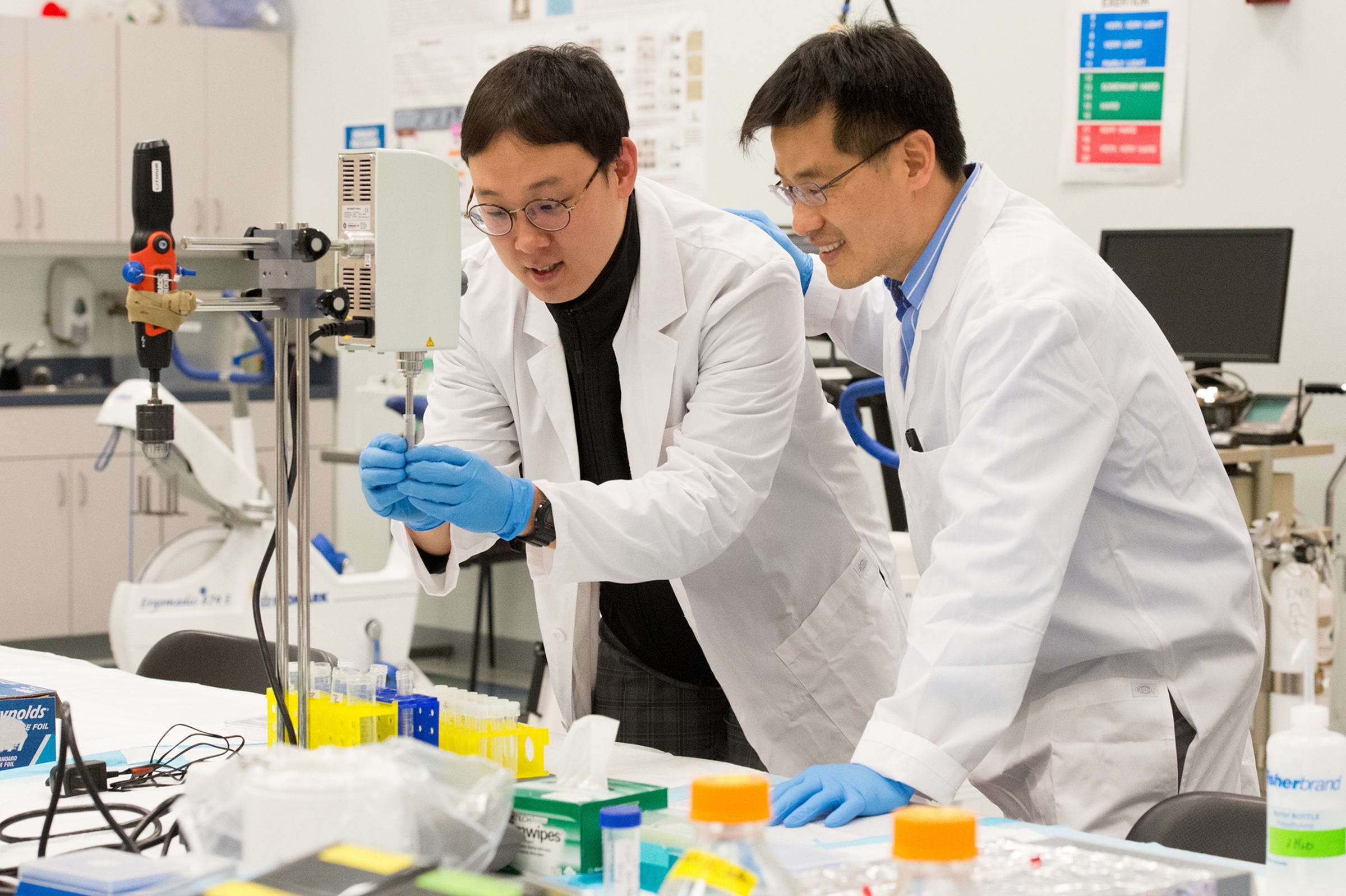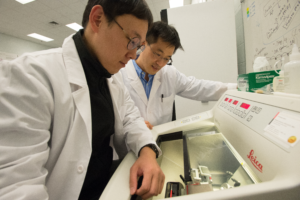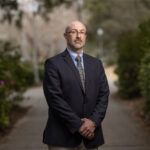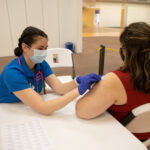Youngil Lee Explores Many Benefits of Exercise
Pensacola – Dr. Youngil Lee spends weekday mornings teaching University of West Florida students. He spends many afternoons in his molecular and cellular exercise physiology laboratory located in the Department of Exercise Science and Community Health.

As an assistant professor, Dr. Lee teaches a full load of classes. It is during the afternoons — and weekends– that he makes time to conduct research and prepare presentations like the one he delivered in the spring at the international conference of the Federation of American Societies for Experimental Biology. The conference was in Boston, and the speech was about acute endurance exercise-mediated autophagy. (Autophagy is the physiological process that removes damaged proteins and small organelles in cells.)
We all know that regular, physical exercise plays a crucial role in maintaining good health, but Dr. Lee is trying to find out how and why.
Lee earned his Ph.D. from the University of Florida, where he studied how exercise protects the heart. After completion of his Ph.D., he spent one year at the Bioscience Center at San Diego State University as a research scholar, focusing on molecular cardiology. He also joined the research group in the School of Pharmaceutical Sciences at the University of California in San Diego as a postdoctoral associate before arriving at University of West Florida. He was born in Seoul, South Korea, where he was a member of the Junior National Gymnastics Team. The intense physical activity piqued a life-long fascination with exercise that affected his career path and research efforts.
Q: Why is research about exercise important?
Lee: Regular physical activities are preventive against cardio-metabolic syndromes contributing to the development of atherosclerosis, high blood pressure, Type 2 diabetes and obesity. Furthermore, growing evidence demonstrates that various kinds of endurance exercise mitigate the aggressive progression of neurodegenerative diseases such as Alzheimer’s and Parkinson’s. Because of this research, we now know why we should be physically active. More important, recent exercise research provides more specific information about what type of exercise and how much duration and frequency can maximize effects. I believe that molecular and cellular exercise physiology research provides an overarching insight into the development of cogent pharmacological strategies for those who cannot perform physical activities due to their physical.
Q: What kind of research are you doing?
Lee: Anti-cancer drug Doxorubicin, DOX, is widely used in cancer treatment. Its potent efficacy on cancer cells, however damages normal cells, which leads to atrophy (the loss of skeletal muscle mass), heart failure, and according to recent studies, brain damage due to its strong toxicity. With this in mind, my research team uses mice to investigate if endurance exercise training after DOX administration attenuates or prevents DOX – induced cardiac and neuro – muscular toxicity. To examine if DOX makes the heart more susceptible to myocardial infarction, we attach hearts of sedentary or exercise-trained mice, to a perfusion system and introduce heart attacks by occluding circulation. Then we observe recovery of cardiac function and assess levels of cell death. We postulate that autophagy will be enhanced by exercise training, leading to maintaining a healthy cellular environment and thus contribute to cellular protection.
Q: Based on your expertise and years of research, what do you want people to know about exercise?
Lee: I would like to inform the general population that regular physical activities help prevent the occurrence of cardio-metabolic syndromes, restore or regenerate brain cells and positively affect blood vessels, all of which are necessary to extend life span and improve quality of life. More significant, recent studies show that higher exercise intensity with more frequency (at least 30 minutes a day for five days a week) provides better cardio protection. Therefore, the more you exercise, the better your health.
Q: You said that University of West Florida and colleagues have been supportive as you continue to build your lab. What has been the evolution of your lab?
Lee: In my beginning year, 2012, when I was hired at UWF, I had no equipment to perform molecular and cellular exercise physiology research. My department chair, Dr. John Todorovich, has always encouraged me to envision establishing an innovative research laboratory by providing invaluable constructive advice and every possible department – level financial support. He also introduced me to college deans such as Drs. Ermalynn Kiehl, Michael Huggins and Pamela Northrup. Also he introduced me to Dr. Rick Harper with the Center for Research and Economic Opportunity and Dr. Richard Podemski (formerly) with Research and Sponsored Programs at UWF. I received significant financial support to set up my laboratory. Moreover, my colleague, Dr. Ludmila Cosio-Lima generously allowed me to share her laboratory space and her grant money for collaborative research. Fortunately, I was able to get decent laboratory tables and chairs from the surplus division and the biology department on campus.
Q: What kind of equipment do you use in your research?
Lee: I have a cell culture system including a biological safety cabinet, a carbon dioxide cell incubator and a fully automatic fluorescent microscope through which I can conduct advanced cardiac and neuroscience research at cellular and molecular levels. These research tools allow me to use recombinant DNA, identify the functions of proteins, and trace locations of specific proteins. Also, I built a cardiac circulation system by which ex vivo (outside the body) models of heart attacks can be performed. Since we recently purchased a Cryotome tissue slicer, which is used to cut very thin tissue sections, we now can conduct experiments to examine whether exercise training minimizes cardiac tissue damages and restores or regenerates damaged cells.
 Post doctoral scholar Yong Chul Jang and Assistant Professor Dr. Youngil Lee work with a cryotome tissue slicer in the molecular and cellular exercise physiology lab in the Department of Exercise Science and Community Health.
Post doctoral scholar Yong Chul Jang and Assistant Professor Dr. Youngil Lee work with a cryotome tissue slicer in the molecular and cellular exercise physiology lab in the Department of Exercise Science and Community Health.
Q: How do you get students interested in research?
Lee: I usually introduce my research and provide a laboratory tour to students who are seriously interested in biomedical research. Students volunteer to help with ongoing experiments and learn basic research skills. I also encourage them to apply for undergraduate research grants. In graduate-level classes, students have an opportunity to learn hands-on skills in class and use them for their theses or graduate research projects.
Q: Why is it important to get students interested in research and working in the lab, even at the undergraduate level?
Lee: I believe that research enhances students’ learning skills, improves knowledge retention and provides hands- on experience. As students acquire scientific skills, they will be able to do research and create a technological innovation that is required to answer other questions. Moreover, through participation in research, students develop critical and logical reasoning skills.
Q: What is your next research goal?
Lee: Our next goal is to develop stroke research wherein we would like to investigate if endurance running exercise can improve brain’s motor function via restoration or regeneration of damaged neurons caused by strokes. To this end, we would like to acquire stroke surgery skills on mice and rat models. Finally, our urgent research goal is to attain external research funding from national and international agencies.
Excerpts from the Experts is a monthly feature that highlights research conducted by UWF faculty.



